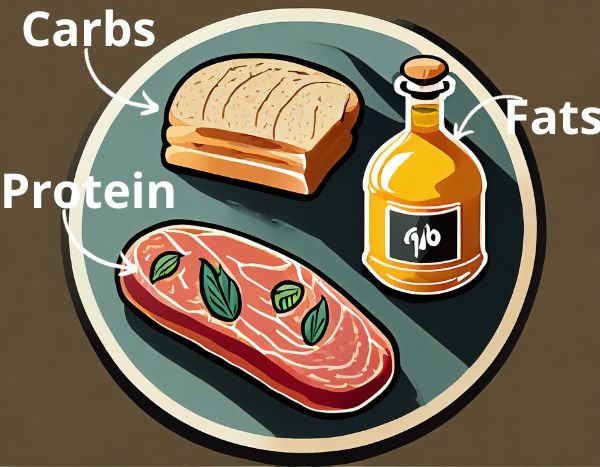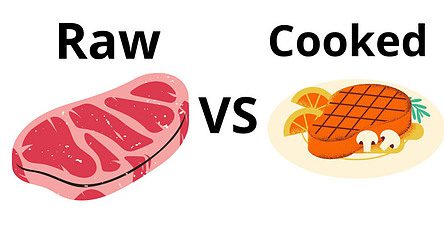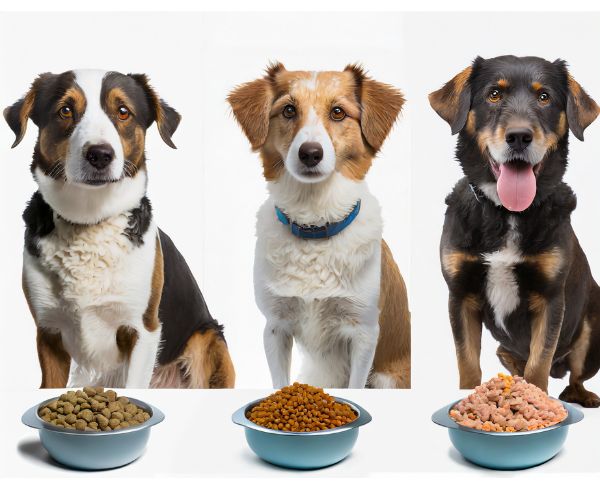Hey there, fellow dog lover! Ever wondered what’s going on inside that rapidly growing furball of yours? Adolescent pups are a bundle of energy, and their nutritional needs are as unique as their playful antics. In this guide, we’ll dive deep into the nutritional requirements for adult dogs, ensuring your pup gets the best fuel for their growth. Ready to embark on this tail-wagging journey? Let’s fetch some knowledge!
The Evolutionary Diet of Dogs

Carnivora Order vs. Dietary Habits
It’s a common misconception that belonging to the Carnivora order automatically makes a species a strict meat-eater. But here’s a fun fact: not all members of this order are exclusive carnivores. Intrigued? Let’s delve deeper.
Dogs: The Adaptable Omnivores
Yes, you read that right! Dogs are omnivores. Over the centuries, our loyal companions have adapted their dietary habits. While their wild ancestors might have had a meat-centric diet, domestication and co-living with humans have expanded their palate. They can have a natural diet or a full meat diet, or even grain-free.
Today, they can digest and derive nutrients from both plant and animal-based foods. So, those veggies you sneak into their bowl? They’re not just fillers; they’re part of a balanced diet!
Debunking Myths: The Carnivore Confusion
The next time someone confidently states, “Dogs are carnivores, right?” you’ve got a nugget of wisdom to share. While they have carnivorous traits, their dietary habits are more aligned with omnivores. So, go ahead and wag your knowledge tail with pride. After all, understanding our pets’ nutritional needs is the first step to ensuring their well-being.
Macronutrients for Adolescent Dogs: Their Nutritional Needs
Proteins: The Powerhouse Nutrient
It’s a common misconception that proteins are all about bulking up those muscles. But in reality, proteins are the unsung heroes of your pup’s diet. They play a pivotal role in almost every cellular function, from repairing tissues to making enzymes and hormones. Think of it as the foundation of your dog’s mansion of health. Want to dive deeper into the world of proteins? Check out this comprehensive guide on dog nutrition by the American Kennel Club.

Fats: More Than Just Calories
Fats often get a bad rap, but they’re essential for our furry friends. They’re crucial for brain development, especially in adolescent pups. Plus, they play a significant role in maintaining skin health and giving that coat a lustrous shine. And let’s clear the air: feeding fats doesn’t mean you’re setting your dog up for obesity. It’s all about balance and understanding the right sources of fats.
Carbohydrates: The Energy Boosters
Carbohydrates often find themselves surrounded by myths, especially in the world of pet nutrition. But here’s the truth: carbs are a quick and efficient energy source for dogs. Those sudden bursts of energy, the zoomies around the park, or the playful chases with their furry pals? Carbs are fueling those moments. So, the next time you come across a myth about carbs in dog food, remember they have their place in a balanced diet.
Micronutrients: The Unsung Heroes
While macronutrients often steal the spotlight, micronutrients play an equally vital role in your pup’s health.
Vitamins: A, D, E, and more. These aren’t just letters but vital components ensuring your pup’s health is top-notch. They aid in everything from vision to bone health, ensuring your dog is not just surviving, but thriving.
Minerals: Ever wondered why your pup’s bones are so strong? It’s not just the milk bones. Minerals like calcium and phosphorus play a crucial role in bone development. And it’s not just about bones; minerals are essential for various bodily functions, ensuring your pup stays in peak health.
Quality Over Quantity: Choosing the Right Dog Food

Decoding Dog Food Labels
Navigating the maze of dog food labels can be daunting. With terms that sound more scientific than appetizing, it’s easy to feel overwhelmed. But fear not, fellow dog lover, I’m here to help you decode the jargon!
Ever felt like you’re reading a foreign language while looking at dog food labels? You’re not alone. But understanding these labels is crucial to ensuring your pup gets the nutrition they deserve.
Here’s a golden nugget of wisdom: the order of ingredients matters. Ingredients are listed by weight, meaning the first few ingredients are the most abundant in the product. So, if you spot real meat at the top, it’s a good sign that the food is rich in high-quality protein. On the flip side, if fillers or by-products dominate the top spots, you might want to reconsider your choice.
Remember, it’s not just about filling their bowl; it’s about filling it with the right stuff. So, the next time you’re shopping for dog food, take a moment to read the label. Your pup will thank you with wagging tails and wet-nosed kisses!
The Debate: Raw vs. Cooked Foods

Ah, the age-old debate that has dog parents divided: raw or cooked? It’s like the canine version of “to be or not to be.” Let’s sink our teeth into this meaty topic, shall we?
To Cook or Not to Cook?
There’s no denying that raw diets have gained popularity in recent years. Proponents argue that it’s the most natural diet, mimicking what wild ancestors would have eaten. They believe raw foods retain more nutrients, leading to shinier coats, healthier skin, and increased energy levels.
On the other paw, the cooked food camp emphasizes safety and digestibility. Cooking can kill harmful bacteria and parasites, making the meal safer for your pup. Plus, some nutrients become more accessible through the cooking process.
Finding the Right Balance
The truth? There’s no one-size-fits-all answer. What works wonders for one dog might not be suitable for another. The key is balance and research. Before making any drastic changes to your dog’s diet, it’s essential to consult with a veterinarian or a pet nutritionist. They can provide insights tailored to your pup’s specific needs.
Every Dog is Unique
Just as we humans have our food preferences and dietary needs, so do our furry friends. Some dogs might thrive on a raw diet, while others might benefit from cooked or even a mix of both. Remember, every dog is unique, and their diet should reflect their individual needs and preferences.
In the end, whether you choose raw, cooked, or a combination, the goal is the same: to provide your pup with a nutritious, balanced diet that keeps them happy, healthy, and wagging their tail!
Tailored Nutrition: Beyond One-Size-Fits-All
Breed-Specific Nutritional Needs

Imagine serving the same portion of food to a toddler and a full-grown adult. Sounds absurd, right? The same logic applies to our furry friends. A Chihuahua isn’t a Great Dane, and their food portions and nutritional needs are worlds apart.
Different breeds have varying energy levels, metabolic rates, and health concerns. For instance, larger breeds might need more joint support, while smaller ones could require energy-dense meals. So, the next time you’re shopping for dog food or preparing a homemade feast, always consider your pup’s breed and size. Tailoring their diet to their specific needs can make a world of difference in their health and happiness.
Life-Stage Nutrition: From Puppies to Seniors
Just as we wouldn’t serve baby food to a teenager or a steak to a toddler, dogs have different nutritional needs at various life stages. Let’s break it down:
- Puppies: These little furballs are growing rapidly and need a diet rich in protein and fat to support their development.
- Adolescents: As they transition from puppyhood, their energy levels skyrocket. Their diet should fuel these active months while supporting continued growth.
- Adults: Now in their prime, adult dogs need a balanced diet that maintains their weight and supports overall health.
- Seniors: As they age, their metabolism slows down. They might need fewer calories but more of specific nutrients to support joint health and other age-related concerns.
In essence, it’s crucial to match your dog’s food to their life stage. By doing so, you’re ensuring they get the right nutrients at the right time, paving the way for a long, healthy, and tail-wagging life!
Practical Tips for Adolescent Dog Nutrition

Portion Control and Monitoring
We’ve all been there – those puppy eyes begging for just one more treat, and before you know it, the treat jar is empty. But here’s the thing: while it’s tempting to spoil our fur babies with extra food and treats, moderation is key. Ever heard the saying, “Too much of a good thing can be bad?” This couldn’t be truer when it comes to feeding our adolescent pups.
Overfeeding can quickly lead to obesity, which brings a host of health issues, from joint problems to heart conditions. So, how do you strike the right balance? Start by understanding the recommended portion sizes for your dog’s breed and size.
And remember, these are just guidelines. You’ll need to adjust based on your pup’s activity level. A couch potato pup might need less than an energetic one who’s always on the go. Regular weigh-ins and body condition checks can also help you ensure you’re on the right track.
Supplements: When and Why?
In an ideal world, a well-balanced diet would provide all the nutrients our dogs need. But sometimes, life throws a curveball, and our pups might need a little extra help. Enter supplements. Whether it’s joint support for larger breeds, skin and coat enhancers, or probiotics for digestive health, supplements can offer that additional boost.
However, a word of caution: not all supplements are created equal, and not all dogs need them. It’s essential to understand the “why” before diving into the world of supplements.
Maybe your dog has a specific deficiency, or perhaps they have a health condition that could benefit from supplementation. Whatever the reason, always consult with a vet before adding any supplements to your dog’s diet. They can guide you on the right type, dosage, and even recommend trusted brands. After all, when it comes to our furry family members, it’s always better to be safe than sorry!
FAQ Section: Addressing Common Queries on Dog Nutrition

Navigating the world of dog nutrition can sometimes feel like you’re lost in a maze of information. But fear not, fellow dog parents! We’ve compiled some of the most frequently asked questions from curious minds like yours. Let’s dive into these questions and shed some light on these common concerns.
Q: Is 30% protein too much for a dog?
A: The protein requirement for dogs can vary based on their life stage, activity level, and overall health. While 30% protein might sound like a lot, many high-quality dog foods contain protein levels in this range, especially those designed for active or working dogs. However, it’s essential to ensure that the protein source is of high quality. Always consult with your veterinarian to determine the appropriate protein level for your specific dog.
Q: How do I calculate my dog’s nutritional needs?
A: Calculating your dog’s nutritional needs involves considering various factors like their weight, age, activity level, and any specific health concerns. While there are general guidelines available, it’s always best to consult with a veterinarian or pet nutritionist. They can provide tailored recommendations based on your dog’s unique needs. Remember, a balanced diet is key, and it’s not just about the quantity but also the quality of the nutrients.
Q: How much does a dog eat per day in KG?
A: The amount a dog eats daily in kilograms varies widely based on their size, breed, metabolism, and activity level. For instance, a small breed dog like a Chihuahua will eat significantly less than a large breed like a Great Dane. Generally, dog food packaging provides feeding guidelines based on weight ranges. However, these are just starting points. Monitoring your dog’s weight, body condition, and consulting with a veterinarian will help fine-tune the exact amount your dog should consume daily.
Remember, every dog is unique, and their dietary needs can change over time. Regular check-ups and open communication with your vet are essential to ensure your pup’s nutritional well-being.
Conclusion: You are a Dogs Nutritional Needs Scientist
Navigating the intricate world of dog nutrition can feel like decoding a complex puzzle. But with the right knowledge and a sprinkle of dedication, it becomes a rewarding journey. Phew! That was a roller-coaster of information, wasn’t it? But every bit is crucial. Our adolescent pups are in a transformative phase, and their dietary needs are paramount in shaping their health and well-being.
Remember, these furry bundles of joy rely on us, their trusted humans, to ensure they get the right nutrition. It’s a responsibility, but also a privilege. So, let’s make every meal count, every treat a celebration, and every bowl a testament to our love and care.

Got questions or stories to share? Maybe a hilarious tale of your pup’s latest foodie adventure or a query about a specific diet? Drop a comment below. Let’s keep the conversation going, fostering a community of informed and caring dog parents. Here’s to raising healthy, happy dogs, one bowl at a time!

